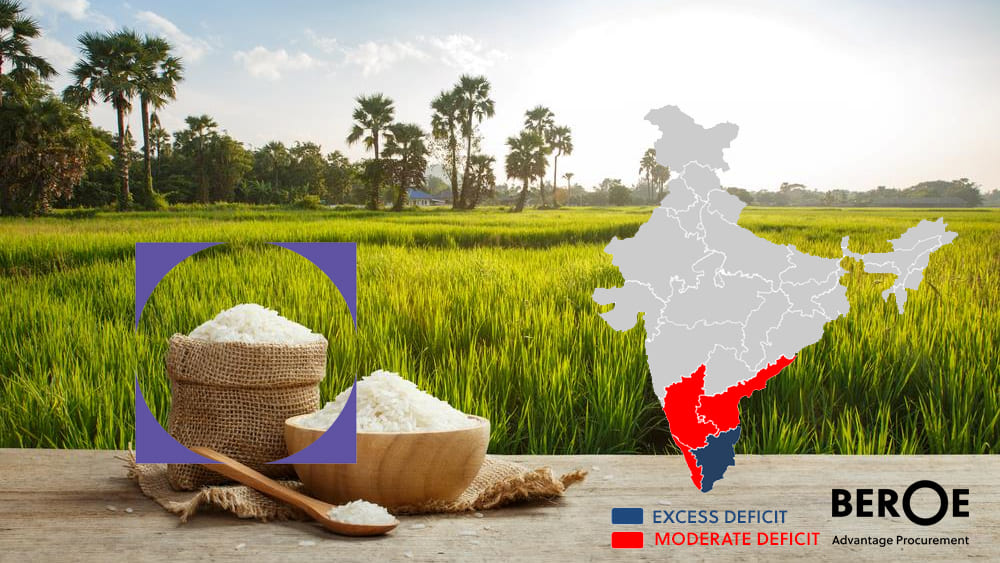
Deficit North-East monsoon adversely affects rice and pulses production; prices may rally

Govindarajan Parthasarathy, Senior Research Analyst -- Agro

The North-East Monsoon that occurs between October and December has withdrawn with a deficit, falling short of the projected 90-100 percent of the long period average (LPA). The Seasonal rainfall occurs over the southern peninsular region comprising Tamil Nadu, coastal Andhra Pradesh, Rayalaseema, Kerala and South interior Karnataka.
The deficit averages 60-70 percent in all regions, with 62 percent for Tamil Nadu, 61 percent percent for Kerala, 67 percent for Coastal Andhra Pradesh, 70 percent for South Interior Karnataka and 66 percent for Rayalaseema.
Tamil Nadu is the most adversely affected region as the state receives 48 percent of total rainfall during this period. Overall, Tamil Nadu reservoirs are 82 percent short of normal levels. Those in Andhra Pradesh, Karnataka and Kerala are 53 percent, 39 percent and 37 percent short respectively.
Rice is the major crop affected as a result of the monsoon deficit, with the bulk of the crop being produced in Tamil Nadu. Pulses have also been adversely affected to a great extent, whereas spices have suffered relatively minor impact of the monsoon deficit. India is not a major global producer of coarse grains, coffee and corn, and hence does not have a significant impact on global oilseed trends.
The shortage in local rice production could lead to an increase in imports. Higher import demand from India could cause export prices to trend upwards. Since India is the global leader in pulses, prices are likely to trend upwards for this commodity as well. Spices have not been greatly affected by the monsoon deficit and hence are likely to show regular pricing trends. India is not a significant global player for the other crops and hence, global prices of these crops could remain unaffected by the monsoon deficit.
|
Crop |
Market Size in World % |
Rank |
|
Crop Prospects |
Implications on Crops |
|
Rice |
3% |
7 |
Tamil Nadu |
|
Paddy acreage in Tamil Nadu, the worst affected state in terms of rainfall deficit, has fallen by 39% in 2016-17 rabi season to 0.718 mha as compared to 1.182 mha in the same period last year |
|
Andhra Pradesh |
|||||
|
|
Rice acreage has declined by 15% to 0.32 mha in the 2016/17 rabi season in comparison to 0.377 mha in the previous year |
||||
|
Kerala |
|
The rice bowls of Palakkad and Thiruvananthapuram districts are the most impacted by monsoon deficit, with 7,027 ha and 4,71,4 ha of farmland affected respectively |
|||
|
Karnataka |
|
The deficit in north-east monsoon has reduced rice acreage in the state |
|||
|
Pulses |
35% |
1 |
Tamil Nadu |
|
Pulses acreage in Tamil Nadu has fallen by 11.7% in 2016-17 rabi season to 0.348 mha as compared to 0.394 mha in the same period last year |
|
Andhra Pradesh |
|
Pulses acreage declined to 0.764 mha, a decline of 18.4% as compared to 0.936 mha in the previous year |
|||
|
Karnataka |
|
Pulses acreage is also reported to have declined in Karnataka |
|||
|
Coarse Grains |
3.2% |
4 |
Tamil Nadu |
|
Acreage of coarse grains also declined in the state by 16.1% from 0.423 mha in the previous year to 0.355 mha this year |
|
Andhra Pradesh |
|
Area under coarse grains fell to 0.169 mha, a decline of 22.8% as compared to 0.219 mha in the previous year |
|||
|
Oilseeds |
6-7% |
2 |
Andhra Pradesh |
|
Area under oilseeds is 68,000 ha, which is reported to be lower than the previous year |
|
Spices |
32% (Cardamom) 18% (Pepper) |
2 |
Kerala |
|
2016/17 Cardamom output is estimated to be 12,000-15,000 MT which is 40% lesser than the figure of 30,000 MT in 2015/16. The pepper crop in Wayanad district of Kerala, the second main growing region is estimated at 2,000-2,500 MT, with vines impacted by deficient rains |
|
Coffee |
3.3% |
7 |
Karnataka |
|
Karnataka accounts for 72% of coffee production in India. Due to poor monsoon, production is likely to decline in Chikmagaluru , Kodagu and Hassan districts of the state, which reduce the country’s arabica and robusta coffee outputs by 7% and 9.8% as compared to the previous year |
|
Corn |
2.4% |
7 |
Tamil Nadu |
|
It is reported that 8,230 ha out of a total acreage of 9,869 ha has been affected by the poor monsoon |
| Excess Deficit | |
| Moderate Deficit |
Related Insights:
View All
Get more stories like this
Subscirbe for more news,updates and insights from Beroe







